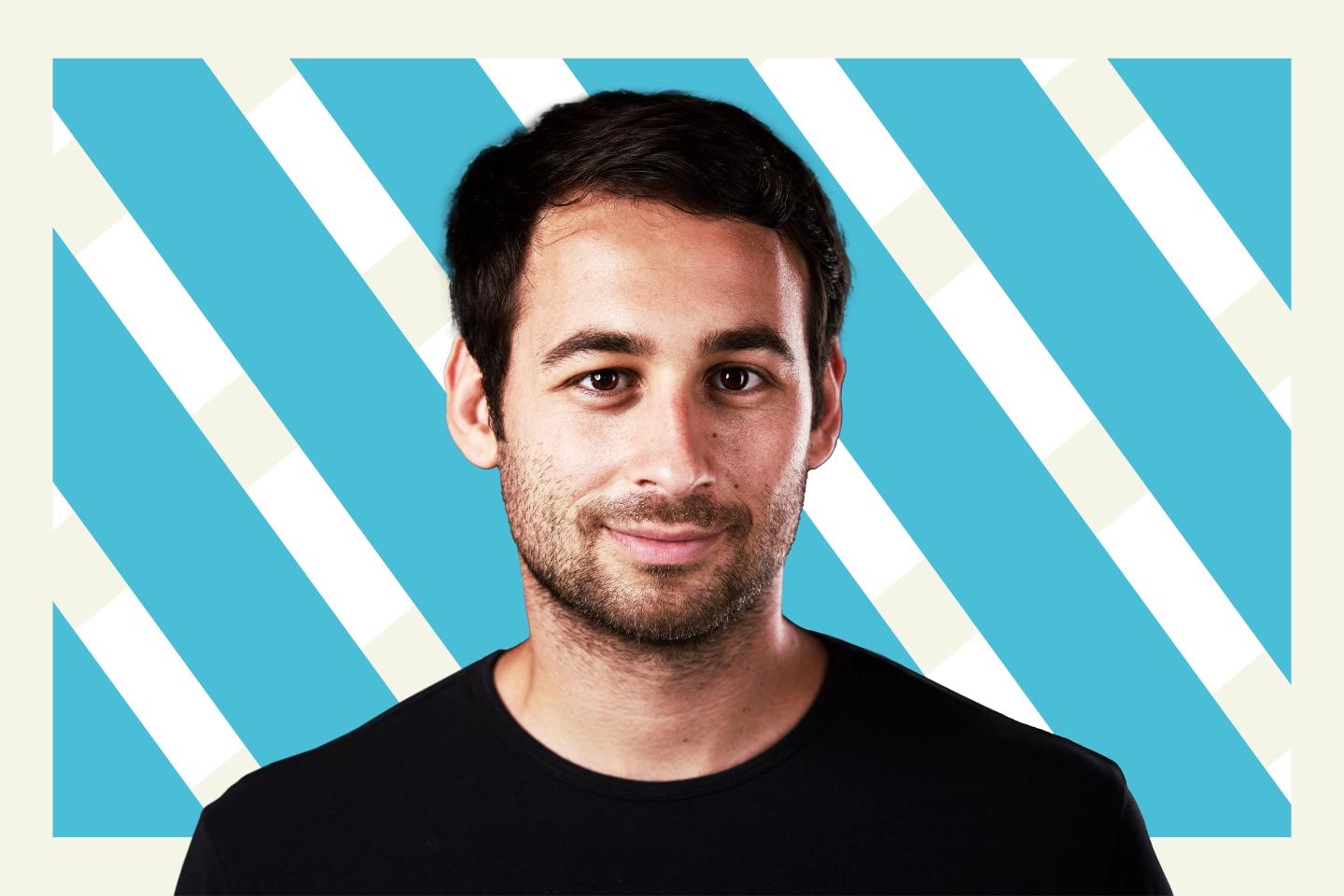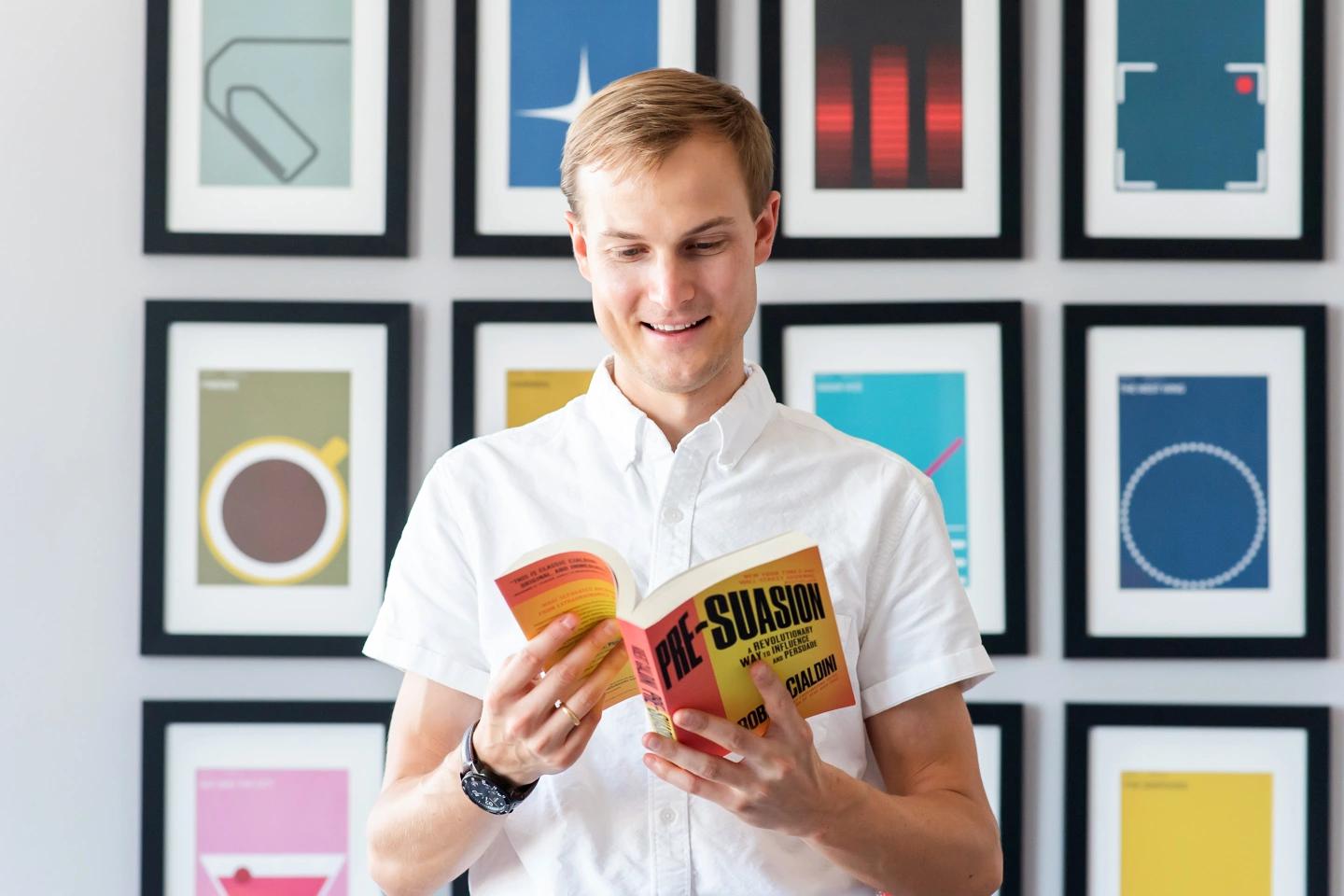
泰勒·奥弗的领英(LinkedIn)主页满是笑话和奇闻轶事,并不像一个可以立即获得宝贵职业建议或深刻商业洞察的地方。
他的领英简介就是他“瞎混时间”的职业生涯历程。在大学二年级的时候,奥弗吹嘘说,他作为一名股票交易处理分析师“学会了如何欺骗系统”,假装自己忙得团团转,而他大部分时间都是“坐在办公桌前放松,听音乐”,或者在隔壁的温蒂汉堡吃鸡块。在另一家公司实习时,他给了伙伴们“一堆免费赠品”;“公司对我的投资回报率肯定是负的。”他说。
但对于在领英上拥有14万粉丝的奥弗来说,他是商业大师。他几乎每天都在分享关于如何在生活和工作中取得成功的想法,关于他的服装公司的最新情况,偶尔也会发布一些表情包——这些内容的浏览量往往达到数百万次。
奥弗告诉《财富》杂志,在他开始在领英上积极发帖时,他创办了电商公司Feat Clothing和位于圣莫尼卡的零售商店,现有20名员工,年收入达1000万美元。阿里·雷斯曼(Aly Raisman)、洛根·保罗(Logan Paul)和烟鬼组合(the Chainsmokers)等名人都穿上了Feat的时髦袜子。据奥弗介绍,当他在奥斯汀、旧金山或洛杉矶时,“人们都能认出他来,找他攀谈,这样的情况每天都会发生好几次”。
“推出像Feat这样的品牌是一种漏斗游戏。这就像:你能在互联网上吸引多少眼球?他声称每次在领英上发帖时,平均能为Feat带来4000美元的销售额。他在领英主页上写道,使用“Linkedinfluencer(领英网红)”代码的客户可以享受优惠价格。
至于他对过去工作的不同寻常的描述,奥弗说,这是诚实和真实的表现。“在某一时刻,我们都只是实习生而已。我们都在瞎混时间,无所事事。我很幸运,我能在那个职位上找到乐趣所在。”
泰勒·奥弗是这一专注于商业的社交网络中特有的一类网红。TikTok上的网红如查莉·达梅利奥(Charli D’amelio),靠舞步走红;油管(YouTube)上的网红如野兽先生(MrBeast),靠特技走红。在领英上,像奥弗这样爱交际的企业家试图通过把自己塑造成创业艺术方面的权威人士来吸引大批粉丝。
而且,正如Instagram、油管和TikTok通过为网红提供各种福利和支持来培养网红一样,微软(Microsoft)旗下拥有8.5亿会员的领英也在投入资金和资源培养自家明星。
约一年半前,该公司聘请了一个由约60名创作者经理组成的团队,通过提供内容创作相关辅导和指导助力奥弗和其他人把握机会。这是该公司向平台上的创作者(网红)投资2500万美元的一部分。该基金的一大旗舰项目是为期六周的领英创作者加速器项目(LinkedIn Creator Accelerator Program),该项目在美国、印度、巴西和英国开展,旨在培养精心挑选的人才利用领英的创作工具、在领英的生活体验以及成功故事。
23岁的斯蒂芬妮·努埃斯(Stephanie Nuesi)在描述她在2021年领英创作者加速器项目中的经历时说:“我们收获了很多——我说的‘很多’是指很多指导,很多关于如何创作内容的不同培训。”努埃斯后来成为了谷歌的一名金融分析师,在培训期间,她被指导如何使用领英工具,如时事通讯和直播,以及如何编辑视频和幻灯片演示,并就成为网红应该做什么和不应该做什么提出了建议。
拥有的粉丝量与杰米·戴蒙相当
领英在培养网红方面的努力是蓬勃发展的创作者经济的最新迹象,这种经济已经造就了无数互联网明星,同时提高了他们所在平台的用户参与度和广告收入。但领英的使命是“连接全球专业人士,让他们更高效、更成功”,它走的道路与其他社交网站略有不同,其他社交网站的人才只需要取悦用户。
西密歇根大学(Western Michigan University)数字营销和电子商务项目主任、营销学教授斯科特•考利(Scott Cowley)表示:“我认为领英现在看到(创作者)带来的巨大机会不足为奇,尤其是在其他一些平台被视为过时的情况下,或者有很多戏剧性的事情发生,比如推特(Twitter)。”对于领英来说,这是一个巨大的机会,可以通过激励真正的优质内容创作者来吸引更多的关注,从而最终达到这一商业模式的目的:增加广告收入。”
该平台的发言人指出,每周有5200万用户在领英上寻找工作,平均每分钟有8人被雇用,9000人建立联系。负责领英北美社区和社论的主管凯蒂•卡罗尔(Katie Carroll)表示:“价值主张非常非常明确,因为你把自己的内容和专业知识放在了专业网络上。”
卡罗尔说,这些内容,加上领英的求职功能和短信功能,已经连续16个季度在平台上创造了“创纪录”的用户参与度,使得该公司在2022年第四季度收入增加7.68亿美元,增幅为26%(这是母公司微软在本财报季的一大亮点)。
长期以来,领英一直为维珍集团(Virgin)的理查德·布兰森(Richard Branson)和阿里安娜·赫芬顿(Arianna Huffington)等知名人士提供发表思想的平台,但该公司也为其他不太出名的用户提供了成为思想领袖的可能性。任何领英用户都可以将他们的个人资料切换到“创作者模式”,将默认操作改为“关注”,而不是“连接”,并突出显示他们的原创内容。拥有超过150名粉丝、新内容、在平台上有良好信誉的创作者可以通过其他方式发布内容,如时事通讯和实时视频和音频。
其结果是,这些人才不拘一格,他们的个性有时会胜过他们的商业信誉。
奥斯汀·贝尔卡克(Austin Belcak)在领英上拥有130多万粉丝,粉丝数量相当于摩根大通首席执行官杰米·戴蒙(Jamie Dimon)。他说自己“非常反对忙碌文化”。(据《纽约时报》报道,忙碌文化是一种表现型工作狂,在领英和WeWork装饰等地方都有体现。)贝尔卡克之所以出名,是因为在2015年被微软聘为合伙人经理之前,他曾被微软拒绝了五次。写下这段经历以及他的其他生活经历,比如早餐只吃拉面,使得他在这个专业社交平台上名声大噪。


现在,他将自己的领英影响力转化为Cultivated Culture,这家公司向付费客户传授“在当今市场上找到自己喜欢的工作的非常规策略(无需人脉、无需传统‘经验’、无需在线申请)。”他对包含"最佳面试答案"的内容包和"进入任何新领域(即使你没有任何经验)"的框架内容收取79美元至447美元的费用。
拥有英语学士学位和工商管理硕士学位的内森·科利尔(Nathan Collier),自2014年以来一直在为高管们代写领英内容。"由于领英这样的平台,如今人们建立声誉的方式有所不同。"他说。
科利尔在领英上帮助过的20多位创业公司高管中,他们几乎都是令人印象深刻的企业家。然而,在一个案例中,科利尔发现该客户伪造证书。他说:"他并不是真的在编故事。这些故事与他在一家公司的真实经历相似,但他夸大了数字。对其中一些人来说,很难看透这一点,所以一旦我发现这种情况,我就停止了与他的合作。"
一个可以打开大门的平台,也可以被人利用
虽然领英有各种系统来清除虚假账户和违反其政策的内容,但该公司并未对合法用户和网红所提出的主张的真实性进行事实核查,因此很难将吹嘘与繁荣区分开。相反,该平台依赖于将内容附加到所谓的职业身份相关的同侪压力,将其作为保持内容真实性的“一个非常重要的因素”(用卡罗尔的话来说)。领英只对有用户提交投诉的个人资料和帖子进行调查。要报告领英个人资料中的不准确信息,用户必须提出正式投诉,包括解释不准确信息并附上数字签名。投诉对象有机会进行反驳,以核实内容的真实性,然后领英版主会做出判断,或者将其返回原投诉人处进行另一轮审核。
当被问及网红传播的未经证实的信息,或冒充网红的潜在欺诈者和假行家所造成的声誉损害风险时,领英的一位发言人分享了一篇10月份博客文章的链接,其中详细介绍了该平台为解决这些问题而实施的新的验证方式和活动传感器。
也许翻车的例子中最臭名昭著的例子是Gravity Payments前首席执行官丹·普莱斯(Dan Price)身上发生的事情,这位社交媒体现象级人物把他所谓的对工人、妇女和少数族裔的公平待遇变成了领英上的近100万粉丝。一位平台发言人表示,在2021年,领英将他提名为他们梦寐以求的顶级声音计划成员,但后来又撤销了这一徽章。今年早些时候,《纽约时报》发表了一篇关于普莱斯的领导力调查,报道称他利用自己的影响力胁迫女性,为糟糕的领导力辩护,并掩盖虐待行为。虽然普莱斯在被指控性行为不端后辞职,但他在领英上仍然相当活跃。11月30日,他为埃隆·马斯克(Elon Musk)辩护的帖子获得了超过1万个赞。普莱斯没有回应《财富》杂志的多次置评请求。
尽管普莱斯代表的极端是令人不安的,但领英平台的粉丝们将其视为一种民主化力量,可以打开原本对他们关闭的大门。在领英上发信息或申请工作,你不需要精英学位或人脉,同样,这项服务可以为某人提供改变人生的平台,让他们展示特殊技能或天赋。
谢尼·莫雷特(Shanee Moret)的情况就是如此。两年前,这位领英创作者还靠食品券过活,并通过自由市场营销工作来维持生计。莫雷特每天在领英上发布多达五次这样的言论:“欣赏比我们想象的更有力量。它可以改变某人的一天。或者它可以改变他们的生活。”这帮助她积累了120万粉丝。
莫雷特之所以一跃成为领英名人,不仅是因为她在工作上取得了成功,还因为她善于利用自己的生活经验来激发职业动力,并在该平台推广视频业务时迅速走红。现在她说,作为成长学院(Growth Academy)的创始人,她每年能赚七位数。成长学院教付费客户如何管理他们的在线形象。就像她做的那样。“我无法相信为什么人们都在关注我。我真的很震惊。”莫雷特说。“他们会说,‘这是因为你发表的言论。’”(财富中文网)
译者:中慧言-王芳
泰勒·奥弗的领英(LinkedIn)主页满是笑话和奇闻轶事,并不像一个可以立即获得宝贵职业建议或深刻商业洞察的地方。
他的领英简介就是他“瞎混时间”的职业生涯历程。在大学二年级的时候,奥弗吹嘘说,他作为一名股票交易处理分析师“学会了如何欺骗系统”,假装自己忙得团团转,而他大部分时间都是“坐在办公桌前放松,听音乐”,或者在隔壁的温蒂汉堡吃鸡块。在另一家公司实习时,他给了伙伴们“一堆免费赠品”;“公司对我的投资回报率肯定是负的。”他说。
但对于在领英上拥有14万粉丝的奥弗来说,他是商业大师。他几乎每天都在分享关于如何在生活和工作中取得成功的想法,关于他的服装公司的最新情况,偶尔也会发布一些表情包——这些内容的浏览量往往达到数百万次。
奥弗告诉《财富》杂志,在他开始在领英上积极发帖时,他创办了电商公司Feat Clothing和位于圣莫尼卡的零售商店,现有20名员工,年收入达1000万美元。阿里·雷斯曼(Aly Raisman)、洛根·保罗(Logan Paul)和烟鬼组合(the Chainsmokers)等名人都穿上了Feat的时髦袜子。据奥弗介绍,当他在奥斯汀、旧金山或洛杉矶时,“人们都能认出他来,找他攀谈,这样的情况每天都会发生好几次”。
“推出像Feat这样的品牌是一种漏斗游戏。这就像:你能在互联网上吸引多少眼球?他声称每次在领英上发帖时,平均能为Feat带来4000美元的销售额。他在领英主页上写道,使用“Linkedinfluencer(领英网红)”代码的客户可以享受优惠价格。
至于他对过去工作的不同寻常的描述,奥弗说,这是诚实和真实的表现。“在某一时刻,我们都只是实习生而已。我们都在瞎混时间,无所事事。我很幸运,我能在那个职位上找到乐趣所在。”
泰勒·奥弗是这一专注于商业的社交网络中特有的一类网红。TikTok上的网红如查莉·达梅利奥(Charli D’amelio),靠舞步走红;油管(YouTube)上的网红如野兽先生(MrBeast),靠特技走红。在领英上,像奥弗这样爱交际的企业家试图通过把自己塑造成创业艺术方面的权威人士来吸引大批粉丝。
而且,正如Instagram、油管和TikTok通过为网红提供各种福利和支持来培养网红一样,微软(Microsoft)旗下拥有8.5亿会员的领英也在投入资金和资源培养自家明星。
约一年半前,该公司聘请了一个由约60名创作者经理组成的团队,通过提供内容创作相关辅导和指导助力奥弗和其他人把握机会。这是该公司向平台上的创作者(网红)投资2500万美元的一部分。该基金的一大旗舰项目是为期六周的领英创作者加速器项目(LinkedIn Creator Accelerator Program),该项目在美国、印度、巴西和英国开展,旨在培养精心挑选的人才利用领英的创作工具、在领英的生活体验以及成功故事。
23岁的斯蒂芬妮·努埃斯(Stephanie Nuesi)在描述她在2021年领英创作者加速器项目中的经历时说:“我们收获了很多——我说的‘很多’是指很多指导,很多关于如何创作内容的不同培训。”努埃斯后来成为了谷歌的一名金融分析师,在培训期间,她被指导如何使用领英工具,如时事通讯和直播,以及如何编辑视频和幻灯片演示,并就成为网红应该做什么和不应该做什么提出了建议。
拥有的粉丝量与杰米·戴蒙相当
领英在培养网红方面的努力是蓬勃发展的创作者经济的最新迹象,这种经济已经造就了无数互联网明星,同时提高了他们所在平台的用户参与度和广告收入。但领英的使命是“连接全球专业人士,让他们更高效、更成功”,它走的道路与其他社交网站略有不同,其他社交网站的人才只需要取悦用户。
西密歇根大学(Western Michigan University)数字营销和电子商务项目主任、营销学教授斯科特•考利(Scott Cowley)表示:“我认为领英现在看到(创作者)带来的巨大机会不足为奇,尤其是在其他一些平台被视为过时的情况下,或者有很多戏剧性的事情发生,比如推特(Twitter)。”对于领英来说,这是一个巨大的机会,可以通过激励真正的优质内容创作者来吸引更多的关注,从而最终达到这一商业模式的目的:增加广告收入。”
该平台的发言人指出,每周有5200万用户在领英上寻找工作,平均每分钟有8人被雇用,9000人建立联系。负责领英北美社区和社论的主管凯蒂•卡罗尔(Katie Carroll)表示:“价值主张非常非常明确,因为你把自己的内容和专业知识放在了专业网络上。”
卡罗尔说,这些内容,加上领英的求职功能和短信功能,已经连续16个季度在平台上创造了“创纪录”的用户参与度,使得该公司在2022年第四季度收入增加7.68亿美元,增幅为26%(这是母公司微软在本财报季的一大亮点)。
长期以来,领英一直为维珍集团(Virgin)的理查德·布兰森(Richard Branson)和阿里安娜·赫芬顿(Arianna Huffington)等知名人士提供发表思想的平台,但该公司也为其他不太出名的用户提供了成为思想领袖的可能性。任何领英用户都可以将他们的个人资料切换到“创作者模式”,将默认操作改为“关注”,而不是“连接”,并突出显示他们的原创内容。拥有超过150名粉丝、新内容、在平台上有良好信誉的创作者可以通过其他方式发布内容,如时事通讯和实时视频和音频。
其结果是,这些人才不拘一格,他们的个性有时会胜过他们的商业信誉。
奥斯汀·贝尔卡克(Austin Belcak)在领英上拥有130多万粉丝,粉丝数量相当于摩根大通首席执行官杰米·戴蒙(Jamie Dimon)。他说自己“非常反对忙碌文化”。(据《纽约时报》报道,忙碌文化是一种表现型工作狂,在领英和WeWork装饰等地方都有体现。)贝尔卡克之所以出名,是因为在2015年被微软聘为合伙人经理之前,他曾被微软拒绝了五次。写下这段经历以及他的其他生活经历,比如早餐只吃拉面,使得他在这个专业社交平台上名声大噪。
现在,他将自己的领英影响力转化为Cultivated Culture,这家公司向付费客户传授“在当今市场上找到自己喜欢的工作的非常规策略(无需人脉、无需传统‘经验’、无需在线申请)。”他对包含"最佳面试答案"的内容包和"进入任何新领域(即使你没有任何经验)"的框架内容收取79美元至447美元的费用。
拥有英语学士学位和工商管理硕士学位的内森·科利尔(Nathan Collier),自2014年以来一直在为高管们代写领英内容。"由于领英这样的平台,如今人们建立声誉的方式有所不同。"他说。
科利尔在领英上帮助过的20多位创业公司高管中,他们几乎都是令人印象深刻的企业家。然而,在一个案例中,科利尔发现该客户伪造证书。他说:"他并不是真的在编故事。这些故事与他在一家公司的真实经历相似,但他夸大了数字。对其中一些人来说,很难看透这一点,所以一旦我发现这种情况,我就停止了与他的合作。"
一个可以打开大门的平台,也可以被人利用
虽然领英有各种系统来清除虚假账户和违反其政策的内容,但该公司并未对合法用户和网红所提出的主张的真实性进行事实核查,因此很难将吹嘘与繁荣区分开。相反,该平台依赖于将内容附加到所谓的职业身份相关的同侪压力,将其作为保持内容真实性的“一个非常重要的因素”(用卡罗尔的话来说)。领英只对有用户提交投诉的个人资料和帖子进行调查。要报告领英个人资料中的不准确信息,用户必须提出正式投诉,包括解释不准确信息并附上数字签名。投诉对象有机会进行反驳,以核实内容的真实性,然后领英版主会做出判断,或者将其返回原投诉人处进行另一轮审核。
当被问及网红传播的未经证实的信息,或冒充网红的潜在欺诈者和假行家所造成的声誉损害风险时,领英的一位发言人分享了一篇10月份博客文章的链接,其中详细介绍了该平台为解决这些问题而实施的新的验证方式和活动传感器。
也许翻车的例子中最臭名昭著的例子是Gravity Payments前首席执行官丹·普莱斯(Dan Price)身上发生的事情,这位社交媒体现象级人物把他所谓的对工人、妇女和少数族裔的公平待遇变成了领英上的近100万粉丝。一位平台发言人表示,在2021年,领英将他提名为他们梦寐以求的顶级声音计划成员,但后来又撤销了这一徽章。今年早些时候,《纽约时报》发表了一篇关于普莱斯的领导力调查,报道称他利用自己的影响力胁迫女性,为糟糕的领导力辩护,并掩盖虐待行为。虽然普莱斯在被指控性行为不端后辞职,但他在领英上仍然相当活跃。11月30日,他为埃隆·马斯克(Elon Musk)辩护的帖子获得了超过1万个赞。普莱斯没有回应《财富》杂志的多次置评请求。
尽管普莱斯代表的极端是令人不安的,但领英平台的粉丝们将其视为一种民主化力量,可以打开原本对他们关闭的大门。在领英上发信息或申请工作,你不需要精英学位或人脉,同样,这项服务可以为某人提供改变人生的平台,让他们展示特殊技能或天赋。
谢尼·莫雷特(Shanee Moret)的情况就是如此。两年前,这位领英创作者还靠食品券过活,并通过自由市场营销工作来维持生计。莫雷特每天在领英上发布多达五次这样的言论:“欣赏比我们想象的更有力量。它可以改变某人的一天。或者它可以改变他们的生活。”这帮助她积累了120万粉丝。
莫雷特之所以一跃成为领英名人,不仅是因为她在工作上取得了成功,还因为她善于利用自己的生活经验来激发职业动力,并在该平台推广视频业务时迅速走红。现在她说,作为成长学院(Growth Academy)的创始人,她每年能赚七位数。成长学院教付费客户如何管理他们的在线形象。就像她做的那样。“我无法相信为什么人们都在关注我。我真的很震惊。”莫雷特说。“他们会说,‘这是因为你发表的言论。’”(财富中文网)
译者:中慧言-王芳
With its mix of jokes and strange anecdotes, Taylor Offer’s LinkedIn page doesn’t immediately come across as a place to get valuable career advice or deep business insights.
His LinkedIn profile is a journey through his career of “messing around.” During his sophomore year in college, Offer boasts that he “learned how to cheat the system” as a stock trade processing analyst, pretending to be busy while he mostly “chilled at [his] desk and listened to music” or noshed chicken nuggets at the Wendy’s next door. As an intern at another company, he gave “a bunch of free swag” to his buddies; the “company definitely took a negative ROI on me,” he notes.
But to the 140,000 followers he has on LinkedIn, Offer is a business guru. Almost every day he shares musings on how to succeed in life and in work, updates about his clothing company, as well as the occasional meme—often racking up millions of views on this content.
Feat Clothing, an e-commerce outfit and Santa Monica retail shop that Offer started around the time he began posting actively on LinkedIn, now has 20 employees and $10 million in annual revenue, he tells Fortune. Celebrities like Aly Raisman, Logan Paul, and the Chainsmokers have donned Feat’s funky socks, and according to Offer, he is recognized and approached “a couple times a day” when he’s in Austin, San Francisco, or Los Angeles.
“Launching a brand like [Feat] is a game of the funnel. It’s like: How many eyeballs can you get anywhere on the internet?” says Offer, who claims to generate an average of $4,000 in Feat sales every time he posts on LinkedIn. Customers who use the code “Linkedinfluencer” can unlock a special deal, his LinkedIn page notes.
As for his unusual descriptions of past jobs, Offer says it’s part of being honest and real. “We were all interns at some point. We all kind of messed around and did nothing,” he says. “I’m lucky to be in a position where I can just have fun with it.”
Offer is among a special breed of internet influencer indigenous to the business-focused social network. TikTok has Charli D’Amelio and her viral dance moves; YouTube has MrBeast and his stunts. On LinkedIn, gregarious entrepreneurs like Offer seek to garner large followings by casting themselves as authorities on the art of making it.
And, just as Instagram, YouTube, and TikTok have cultivated their roster of influencers by providing them with various perks and support, LinkedIn, which is owned by Microsoft and has 850 million members, is pouring money and resources into developing its own crop of homegrown stars.
Around one and a half years ago, the company hired a team of about 60 creator managers who help Offer and others harness opportunity by guiding content, providing coaching and mentorship. It’s part of the company’s $25 million investment into creators—influencers—on the platform. A flagship of the fund is the six-week LinkedIn Creator Accelerator Program, available in the U.S., India, Brazil, and the U.K, which educates handpicked talent on utilizing LinkedIn’s creation tools, life within LinkedIn, and its success stories.
“We had a lot—and when I say ‘a lot,’ I mean a lot—of guidance, a lot of different trainings on how to create content,” says 23-year-old Stephanie Nuesi, describing her experience in the 2021 LinkedIn Creator Accelerator Program. During the training, Nuesi, who has since become a financial analyst at Google, was instructed on how to use LinkedIn tools like newsletters and livestreaming, as well as how to edit videos and slide presentations, and counseled on the dos and don’ts of being an influencer.
As many followers as Jamie Dimon
LinkedIn’s influencer efforts are the latest sign of the booming creator economy, which has minted countless internet stars while boosting user engagement, and advertising revenue, on the platforms that host them. But with its mission to “connect the world’s professionals to make them more productive and successful,” LinkedIn is treading a slightly different path than other social networks where the talent need only entertain users.
“I don’t think it’s any great surprise LinkedIn sees a big opportunity [in creators] right now, especially where some of the other platforms are being seen as stale, or there’s a lot of drama a.k.a. Twitter,” says Scott Cowley, marketing professor and director of the Digital Marketing and E-Commerce Program at Western Michigan University. “There is a tremendous opportunity for LinkedIn to draw more attention to the platform through incentivizing really good content to ultimately serve the purpose of the business model: increase ad revenue.”
Every week on LinkedIn, 52 million users seek jobs, and every minute an average of eight people are hired and 9,000 connect, notes a spokesperson for the platform. “The value proposition is very, very clear, because of the fact that you are putting your content and your expertise out there in front of a professional network,” says Katie Carroll, who oversees communities and editorial for LinkedIn North America.
This content, along with LinkedIn’s job search functions and messaging, has led to “record” engagement on the platform for 16 straight quarters, Carroll says, helping to increase revenue by $768 million—or 26%—in the fourth quarter of 2022 (a highlight for parent Microsoft this earnings season).
While LinkedIn has long offered established moguls like Virgin’s Richard Branson and Arianna Huffington a platform to publish their thoughts, the company has added options for other not-quite-so-famous users to become thought leaders. Any LinkedIn user can switch their profile to “creator mode,” which changes the default action to “follow” rather than “connect” and highlights their original content. Creators with over 150 followers, fresh content, and good standing on the platform can post content via additional means like newsletters and live video and audio.
The result is an eclectic assortment of characters whose personality sometimes outshines their business bona fides.
Austin Belcak, who has over 1.3 million LinkedIn followers—a following about equal to that of JPMorgan Chase CEO Jamie Dimon—says he is “very anti–hustle culture.” (Hustle culture is performative workaholism that has manifested on LinkedIn and places like WeWork decor, per the New York Times.) Belcak’s claim to fame is his purported rejection by Microsoft five times over before the company hired him as a partner manager in 2015. Writing about this and his other life experiences, like surviving on ramen for breakfast, helped him gain fame on the professional networking platform.
Now he’s translated his LinkedIn influence into Cultivated Culture, a company that educates paying customers on “unconventional strategies to land jobs they love in today’s market (without connections, without traditional ‘experience,’ and without applying online.” He charges between $79 to $447 for content packages containing his “best interview answers,” and framework to “break into any new field (even if you have ZERO experience).”
Nathan Collier, who has a bachelor’s in English and an MBA, has been ghostwriting executives’ LinkedIn content since 2014. “People build their reputations in different ways today because of platforms like LinkedIn,” he says.
Nearly all of the 20-plus startup executives that Collier has helped on LinkedIn have been impressive entrepreneurs. In one case, however, Collier realized a client had faked his credentials. “It wasn’t really like he was making up stories. They were similar to his real experience with a company, but he was inflating the numbers,” he says. “It’s hard to see through that with some of these people, so I stopped working with him once I figured out that was happening.”
A platform that can open doors—and be gamed
While LinkedIn has various systems in place to weed out fake accounts and content that violates its policies, the company does not fact-check the veracity of the claims made by legitimate users and influencers, making it difficult to separate puffery from prosperity. Rather, the platform relies on the peer pressure associated with attaching content to a purported professional identity as “a really great factor” (Carroll’s words) to keep content factual. LinkedIn only investigates profiles and posts with a user-submitted complaint. To report inaccurate information on a LinkedIn profile, users have to make a formal complaint, which involves writing an explanation of the inaccurate information along with a digital signature. The subject of the complaint has the opportunity to make a counterstatement to verify their content, and then a LinkedIn moderator makes a judgment call or takes it back to the original complaint for another round of vetting.
Asked about the risk of reputational damage from unverified information spread by influencers, or from potential fraudsters and charlatans posing as influencers, a LinkedIn spokesperson shared a link to an October blog post detailing new verification and activity sensors that the platform has implemented to help combat these issues.
Perhaps the most notorious example of what could go wrong is ex–Gravity Payments CEO Dan Price, a social media phenomenon who turned his purported fair treatment of workers, women, and minorities into nearly 1 million followers on LinkedIn. In 2021 LinkedIn named him to their coveted Top Voices program for this content, but has since revoked the badge, says a platform spokesperson. Earlier this year the New York Times published an investigation on his leadership, reporting that he used his influence to coerce women, justify poor leadership, and cover up abuse. Though Price resigned after accusations of sexual misconduct, he continues to be fairly active on LinkedIn, where his posts, like a Nov. 30 defense of Elon Musk, attract over 10,000 likes. Price did not respond to Fortune’s multiple requests for comment.
While Price represents a disturbing extreme, fans of LinkedIn’s platform see it as a democratizing force that can open doors that would otherwise be closed to them. You don’t need elite degrees or networks to message anyone or apply for any job on LinkedIn, and by the same token, the service can provide a life-changing platform for someone to showcase a special set of skills or talent.
That was the case for Shanee Moret. Two years ago the LinkedIn creator was living off food stamps and working as a freelance marketer to stay afloat. Moret was posting on LinkedIn up to five times a day with sayings like: “Appreciation is more powerful than we think. It can change someone’s day. Or it can change their life,” that helped her accumulate 1.2 million followers.
More than Moret’s success at her job, it was her knack for tapping her life experience for career motivation, and going viral with the platform’s push into video, that catapulted her to LinkedIn celebrity. Now she says she makes seven figures annually as the founder of the Growth Academy, which teaches paying customers how to curate their online presence. Just like she did. “I couldn’t believe why people were watching me. I was actually shocked,” says Moret. “They’re like, ‘It’s what you say.’”






